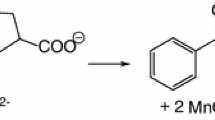Abstract
The solution degradation of the antiinflammatory agent 5-aminosal-icylic acid (5-ASA) was investigated in order to elucidate a mechanism for degradation. Two degradation pathways were considered: decarboxylation by analogy to 4-aminosalicyclic acid (4-ASA) decomposition and oxidation from consideration of 5-ASA's aromatic ring substitution pattern (i.e., relation to p-aminophenol). The oxidation of 5-ASA was investigated using cyclic voltammetry and flow electrolysis. These studies showed that 5-ASA is more easily oxidized than is 4-ASA and that 5-ASA undergoes a two-electron, two-proton oxidation consistent with formation of 5-ASA-quinoneimine (5-ASA-QI). This oxidation is followed by subsequent complex chemistry. The decomposition of 5-ASA in solution was examined under a variety of conditions. 5-ASA decomposes most rapidly under conditions promoting oxidation and is most stable under conditions tending to inhibit oxidation. Decarboxylation was not found to be a significant degradation pathway.
Similar content being viewed by others
REFERENCES
U. Klotz. Pharmacokinetic properties of 5-aminosalicylic acid (mesalazine). Falk Symp. 46:339–347 (1988).
S. Bondesen, S. N. Rasmussen, J. Rask-Madsen, O. H. Nielsen, K. Lauritsen, V. Binder, S. H. Hansen, and E. F. Hvidberg. 5-Aminosalicylic acid in the treatment of inflammatory bowel disease. Acta Med. Scand. 221:227–242 (1987).
E. Brendel, I. Meineke, E. Stüwe, and H. Osterwald. Stability of 5-aminosalicylic acid and 5-acetylaminosalicylic acid in plasma. J. Chromatogr. Biomed. Appl. 432:358–362 (1988).
C. Fischer, K. Maier, and U. Klotz. Simplified high-performance liquid chromatographic method for 5-aminosalicylic acid in plasma and urine. J. Chromatogr. 225:498–503 (1981).
H. A. Montgomery, F. M. Smith, B. E. Scott, S. J. White, and K. B. Gerald. Stability of 5-aminosalicylic acid in plasma. Am. J. Hosp. Pharm. 43:118–120 (1986).
I. Cendrowska, M. Drewnowska, A. Grzeszkiewicz, and K. Butkiewicz. Investigation of the stability of 5-aminosalicylic acid in tablets and suppositories by high-performance liquid chromatography. J. Chromatogr. 509:195–199 (1990).
R. F. Rekker and W. T. Nauta. The U.V. absorption spectra of p-amino-salicylic acid and some related compounds. III. The decomposition of p-amino-salicylic acid in aqueous solutions. Pharm. Weekbl. 91:693–704 (1956).
S. G. Jivani and V. J. Stella. Mechanism of decarboxylation of p-aminosalicylic acid. J. Pharm. Sci. 74:1274–1282 (1985).
G. E. Dunn, E. G. Janzen, and W. Rodewald. Mechanism of decarboxylation of substituted salicylic acids. I. Kinetics in quinoline solution. Can. J. Chem. 46:2905–2909 (1968).
W. K. Snead and A. E. Remick. Studies on oxidation-reduction mechanism. II. The anodic oxidation of p-aminophenol. J. Am. Chem. Soc. 79:6121–6127 (1957).
T. Nomura. Indirect polarographic determination of microgram amounts of iron by means of the catalytic oxidation of 5-aminosalicylic acid. J. Electroanal. Chem. 124:213–219 (1981).
B. J. Dull, K. Salata, A. v. Langenhove, and P. Goldman. 5-Aminosalicylate: Oxidation by activated leukocytes and protection of cultured cells from oxidative damage. Biochem. Pharmacol. 36:2467–2472 (1987).
O. I. Aruoma, M. Wasil, B. Halliwell, B. M. Hoey, and J. Butler. The scavenging of oxidants by sulphasalazine and its metabolites. Biochem. Pharmacol. 36:3739–3742 (1987).
I. Ahnfelt-Rønne and O. H. Nielsen. The antiinflammatory moiety of sulfasalazine, 5-aminosalicylic acid, is a radical scavenger. Agents Actions 21:191–194 (1987).
H. Strøm and I. Ahnfelt-Rønne. Second-line anti-rheumatic drugs and free radical scavenging. Agents Actions 26:235–237 (1989).
J. R. A. Pollock and R. Stevens (eds.). Dictionary of Organic Compounds, 4th ed., Eyre and Spottiswoode, London, 1965, Vol. 1, p. 141.
D. J. Miner and P. T. Kissinger. Evidence for the involvement of N-acetyl-p-quinoneimine in acetaminophen metabolism. Biochem. Pharmacol. 28:3285–3290 (1979).
P. T. Kissinger and W. R. Heineman. Laboratory Techniques in Electroanalytical Chemistry, Marcel Dekker, New York, 1984.
R. A. Friedel and M. Orchin. Ultraviolet Spectra of Aromatic Compounds, John Wiley and Sons, New York, 1951.
H. v. Euler, H. Hasselquist, and Uno Lööv. Oxydation des 5-aminosalicylsäure-äthylesters. Arkiv Kemi Mineral. Geol. 25A:No. 14 (1948).
P. V. Khadikar and P. S. Deshmukh. Protonation constants of salicylic substituted salicylic acids. J. Ind. Chem. Soc. 54:101 (1977).
H. Allgayer, J. Sonnenbichler, W. Kruis, and G. Paumgartner. Determination of the pK values of 5-aminosalicylic acid and N-acetylaminosalicylic acid and comparison of the pH dependent lipid-water partition coefficients of sulphasalazine and its metabolites. Drug Res. 35(II):1457–1459 (1985).
M. De Vos, H. Verdievel, R. Schoonjans, R. Beke, G. A. De Weerdt, and F. Barbier. High-performance liquid chromatographic assay for the determination of 5-aminosalicylic acid and acetyl-5-aminosalicyclic acid concentrations in endoscopic intestinal biopsy in humans. J. Chromatogr. Biomed. Appl. 564:296–302 (1991).
E. J. D. Lee and S. B. Ang. Simple and sensitive high performance liquid chromatographic assay for 5-aminosalicylic acid and acetyl-5-aminosalicylic acid in serum. J. Chromatogr. Biomed. Appl. 413:300–304 (1987).
E. Brendel, I. Meineke, D. Witsch, and M. Zschunke. Simultaneous determination of 5-aminosalicylic acid and 5-acetylaminosalicylic acid by high-performance liquid chromatography. J. Chromatogr. 385:299–304 (1987).
S. H. Hansen. Assay of 5-aminosalicylate and its acetylated metabolite in biological fluids by high-performance liquid chromatography on dynamically modified silica. J. Chromatogr. Biomed. Appl. 226:504–509 (1981).
E. Nagy, I. Csipo, I. Degrell, and G. Szabo. High-performance liquid chromatographic assay of 5-aminosalicylic acid and its acetylated metabolite using electrochemical detection. J. Chromatogr. Biomed. Appl. 425:214–219 (1988).
Author information
Authors and Affiliations
Rights and permissions
About this article
Cite this article
Palsmeier, R.K., Radzik, D.M. & Lunte, C.E. Investigation of the Degradation Mechanism of 5-Aminosalicylic Acid in Aqueous Solution. Pharm Res 9, 933–938 (1992). https://doi.org/10.1023/A:1015813302412
Issue Date:
DOI: https://doi.org/10.1023/A:1015813302412




